*New*
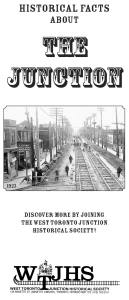 From our “Junction Historical Facts” pamphlet [compiled by Frank Remiz] available free at our archives:
From our “Junction Historical Facts” pamphlet [compiled by Frank Remiz] available free at our archives:
<<<<<<<<Temporarily removed for correction>>>>>>>>>>>>
And, speaking of the Junction, from our newsletter’s Centennial Edition of 2008:
© Neil Ross, 2008
The Junction is celebrating the Centennial of its incorporation as an independent city in 1908, which it remained for one year and nineteen days. Then it joined Toronto as an equal: 
So there you have it: “Junction City” began with plans for a party and an act of independent spirit. It was not called “Junction City” but rather the City of West Toronto; an alias, of course. Everyone up and down the line knew it as simply the Junction. In this special Centennial Edition of the Leader and Recorder, we’ll preview the party coming up in the Centennial year and reflect on the independent spirit that got us here.
JUNCTION OF THE NATIONAL DREAM
Originally the meeting place of two first nation’s trails, the Junction was on a portage route to a Seneca Village at Baby Point, in strategic location to hold control ofthe Humber River. After the American Revolution, Governor John Graves Simcoe carved out Yonge and Dundas Streets as supply routes to fend offthe inevitable American attack. One of the first estates, Aikenshaw, was near what is now No Frills on Pacific Avenue, just south of Dundas Street West. Legend tells us that its fields were cultivated by the hands of former slaves who had come up via the Underground Railway.
Ironically, given it’s later “dry years,” the early Junction consisted of a couple of taverns, slaking the thirsts of farmers coming to and from market. In the Upper Canada Rebellion, William Lyon Mackenzie and his rebels robbed the royal mail coach at the Peacock Inn, just outside of what is now Coffee Time Donuts at Old Weston Road and Dundas Street. For years, much of this area was given to sport. W.C. Keele laid out the Carleton Race Course: along Annette Street, down Pacific Avenue, onto Glenlake Avenue on to the home stretch up High Park Avenue. The first few runnings of the Queen’s Plate were held there and the first horse to win was named Don Juan.
And then came D.W. Clendenan. The King of the Junction as David Wencer’s article calls him in the Legends of the Junction portrait. D.W. Clendenan bought up the race course and adjacent lands and laid out a village that would become a town and then a city. He was first mayor of the village and the town, but like Moses didn’t make it all the way to the promised land of the city. Unlike Moses he left in a delicious cloud of scandal.
Canada came together at the Junction. While the hammering in of the last spike would complete the railway in the West, the CPR brought its Ontario and Quebec lines into the Junction to merge with the Toronto, Grey and Bruce, and its Credit Valley line. The country was complete from coast to coast.
Tory Toronto now had a more progressive rival living to the rhythms of the Firemen’s Bell which rang three times a day.
Women predominated in the Junction. (See Kristen Buckley’s portrait of Dr. Minerva Reid.) Midwives and doctors and school principals. The Temperance movement, now scorned, was a progressive and humanist outfit, with a devotion to the rights of women and children. Anyway, the Junction took to temperance like a drunkard took to drink, and passed the Local Option to remain dry until 1996,
The Junction has always been a meeting place for business and the arts. Its first book store and art gallery is where Post and Beam Reclamation is now on 2869 Dundas Street West. The Heintzman Piano Factory turned out rivals to Steinway where the Options for Homes concominium project are going in at the site of the old Canadian Tire store on Keele Street, just north of Dundas West The Junction College of Music serenaded the Heart of the Junction at Keele and Dundas Streets from the open windows of the Campbell Block. It was a happening town.
RENASCENT CITY
A.B. Rice, the dean of Junctions writers, covered village, town, city and neigbourhood for forty years. In his 1943 column Stray Thoughts on Matters of Public Concern he describes the “Three Phases of Life in the Junction.” The Land Boom (1884-1892), the Slough of Despond, (1892-1897), and the Renascent Period (1897-1909). It was at the peak of the third period that the Junction incorporated. But the Renascent Period began with the honking of a horn.
C.C.M, the Canadian Cart and Motor Company introduced the Russell Model A, “the thoroughly Canadian Car, made with Canadian materials, Canadian labour and Canadian capital,” and a powerful Knight engine, By the time it rolled off the assembly at Weston Road and St. Clair Avenue, the Junction’s Slough of Despond was over.
As early as 1907 there had been a movement for a: “Greater Toronto Junction rather than a Greater Toronto” and some would “suggest that we extend our town west as far as Jane Street and north to St. Clair Avenue. Make it an independent city, and get power to run it.” (For the full boundaries of “Junction City” see the map in this issue.)
January 22. In the words of the Telegram’s laconic scribe: “Council did not lounge as long as usual in the saddle bags last night . . . Within two little hours the members thereof had decided to convert the busy railroad town into a city; to call it West Toronto [Editor’s Note: a controversial choice – but the Mayor liked it]. Goodness alone knows how much more Council would have decided to do had there been no hockey match that night.”
Junction folk were “so confident of the future greatness of the little city,” A.B. Rice wrote, “that they thought little of possible union with Toronto. The community was proud of the difficulties they had overcome and they were happy.”
Happy at the prospects of the Champion Junction Shamrocks Junior lacrosse team — the lions of the young city — enjoying a running battle with the Suburban Railway Company whose streetcars inexplicably stopped at Humberside Avenue and refused to travel on to KeeleStreet; watching police raids at “Temperance Hotels”, fretting over the ever present costs of getting water to the Junction, and thrilling to the exploits of a local Sherlock Holmes who solved a crime by the evidence of fingerprints on a dusty picture frame. The city’s assessment was reported as $6 Million and the Chairman “ventured the opinion there would be no increase in taxation.”
On April 22, 1908, a Commemoration Feast in honor of birth of the city was held at City Hall on Keele Street just south of Dundas Street West, where the Fire Hall is now. Attendees toasted the King and drank to the Dominion of Canada. The Telegram reports that only lemonade was consumed. W.F. Maclean, the local Member of the Provincial Parlaiament, replied to the toast with the declaration that he ‘was a Canadian, nothing but a Canadian, that he would not be anything else if he could.’ Whereupon, every present felt more at ease,” observed the Telegram.
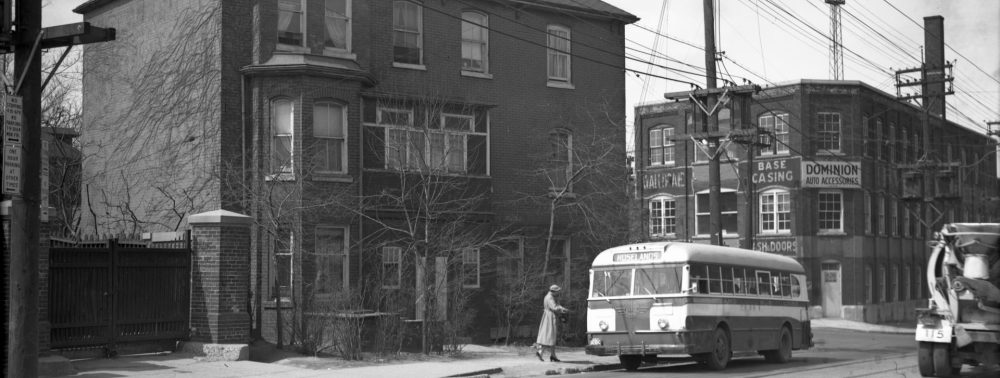
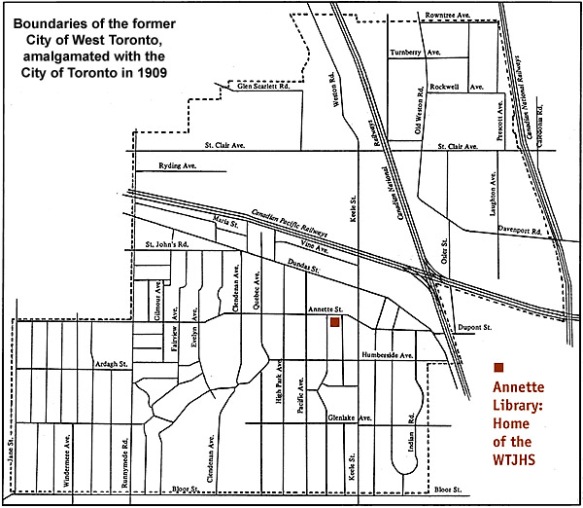

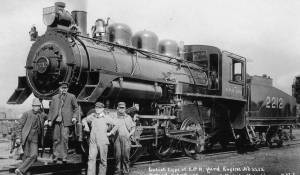
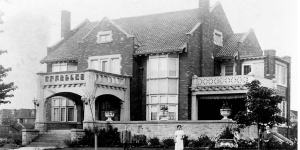

Pingback: 4 neighbourhoods that will love their SmartTrack station – Daniel McKenzie
Pingback: Block Republic Attending The Junction Summer Solstice Festival 2017